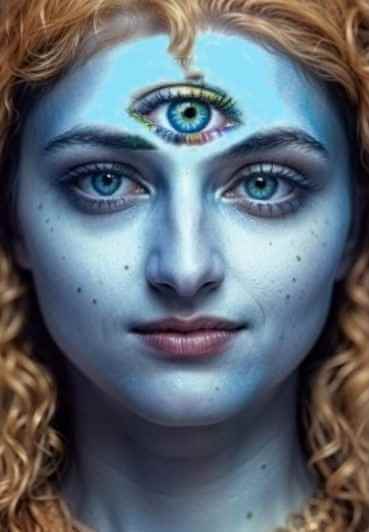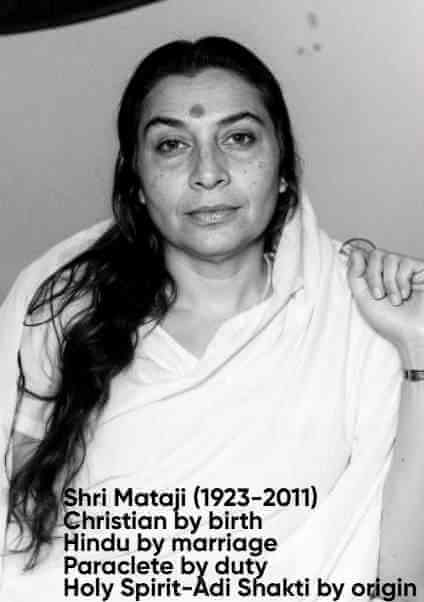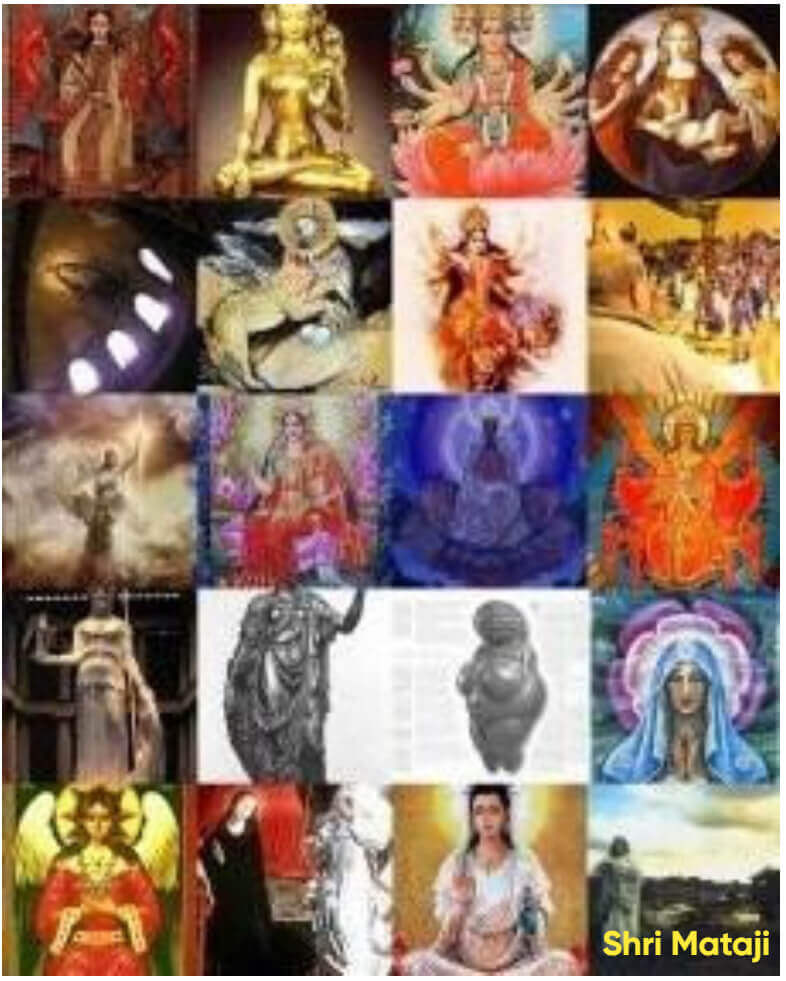They say that at Sahasrara when the Goddess will appear She will be Mahamaya
This forum post reflects on the profound teachings of Sahaja Yoga regarding the Sahasrara chakra and the appearance of the Goddess as Mahamaya. Drawing from Shri Mataji Nirmala Devi’s revelations, it explores the subtle nature of divine perception, the role of illusion in spiritual evolution, and the transformative experience of Self-Realization. Through personal insights and scriptural references, the post invites seekers to contemplate the mystery of the Sahasrara—the gateway to the Kingdom of God within.
—- In shriadishakti@yahoogroups.com, ashishcool tandon <ashishcooltandon@y...> wrote:
Dear Brother Jagbir,
JSMJ,
Would request you to kindly explain the below.
He hovered above the semi-circle of the Primordial Beings already assembled, and then slowly floated down towards his spiritual body that was meditating beside the Great Adi Shakti.
Kash's corporeal body merged into his spiritual Self, fitting into it perfectly from head to toe. Kash, now in the ethereal form of the spirit.
Love
Ashish
Response from Jagbir Singh
Dear Ashishji,
There is no description of the Sahasrara (Kingdom of God) in any scripture. The closest is the Shri Lalita Sahasranama. Shri Mataji is the first to explain about it, also claiming that She lives there as Shri Mahamaya.
"They say that at Sahasrara when the Goddess will appear, She will be Mahamaya. Is it possible to be anything else in the world of today to come on this Earth? Any type of incarnation could have been in great trouble because human beings in their ego are highest in Kali Yuga. So they are quite stupid and they are capable of doing any kind of harm or violence to a Divine personality. It is not at all possible to exist in this world as anything else than Mahamaya ...
It has no power or any intention of giving you wrong ideas or something that is false. It is there whatever, it is Truth. So in a way to say that Mahamaya is the one which deludes is wrong ...
I need not be before you; I can be just here in Nirakar, in Formless, but how to communicate; how to have a rapport. For that, one has to come in the form of Mahamaya so that there is no fear, there is no distance — one can come close and understand, because if this Knowledge has to be given, if Realization has to be given, people have to at least sit before the Mahamaya. Otherwise, if they all run away, what's the use? To create that extremely human personality in Sahasrara, She comes as Mahamaya."
— Shri Turya Devi
Mahamaya's Doings, Sahasrara Puja, Cabella, Italy — May 8, 1994
Turya (262nd): The Fourth. This state is beyond the three states mentioned above (259. Taijasatmika; 260. Supta; and 261 Prajnatmika).
"Now one must learn how to improve Sahasrara itself. You must know the presiding Deity of the Sahasrara very well . . . But this Deity has to be established first into the heart. Now you are very lucky people that you have the Deity in person with you. The people who got Realization before I came on this Earth had to imagine the Deities. And in that imagination they were never perfect. But as they say that at Sahasrara She is Mahamaya; that is how it is described. So if you see that Person you may not be knowing fully that Person, or in a perfect way, or a complete way. Because Mahamaya Shakti is much greater than your imagination. That is why one has to surrender. With your limited imagination, or brain, you can not see the Deity."
— Shri Sadgati-Prada Devi
The New Era, MahaSahasrara Puja, Rouen, France — May 5, 1984
Sadgati-Prada (201st): Here 'Sat' means Truth, a good path. She leads devotees to the highest status or Reality, which is Herself.
Thus, if the Golden Goddess exists within, surely some souls can visit Her. Even ex-world leader Yogi Mahajan, the instigator of the 1452 Inquisytion agrees that "Only those who go deep in the source discover the Golden Goddess that resides within. Her touch enlightens and enthralls the total being. It is indeed the miracle of miracles. This miracle resides in every being. The wise pursue it, the scriptures speak of it, and the saints glory in its praise."
Unfortunately for reasons best known to him and his cronies those who (did) go deep in the source and discovered that the Golden Goddess did reside within had to be demonized and their character assassinated at all costs.
In the beginning both Kash and myself taught he was having OBE (Out Of Body) experiences. Both of us believed that he left his physical body whenever he meditated and traveled across the universe to meet the Shakti who then took him across the universe. She had even taken him back into time to witness and confirm scriptural revelations. Among the more important were his visiting Shri Shiva at Mount Kailash in the Himalayas; going back into time to the ancient land of Galilee to corroborate Lord Jesus' Resurrection; passing through the Black Hole to worship Shri Ganesha in His Temple; sitting on the Shesnaag of Shri Vishnu floating on the Milky Ocean; visiting the Heavenly Realm of Shri Buddha; and travelling to other celestial paradises.
On April 28, 1995, at 7:10 a.m. he was told to ask Shri Mataji to reveal how he travels in this Universe to meet Her.
Although he insisted that he left his physical body to do so, there were many questions: How exactly does he reach the spiritual world? How does he leave this gross physical body? Where actually his real self is during meditation? Does he become the spirit and leave behind his material body on Earth? How far does he have to travel to reach the Kingdom of God?
The priceless answers to these universal questions would be welcome by all. For ages saints and sages had given glimpses of this phenomenon known as 'out-of-body-experiences' or astral traveling. These questions had to be answered by a Higher Being, and all existing speculation put to rest.
As he meditated his Kundalini surged through his body all the way up his Sushumna Nadi, passed the Narrow Gate at the chiasma opticalis, through the spiritual clouds and emerged into the Sahasrara. The Everlasting Light shone ever so brightly from behind the Eternal Throne of the Great Celestial Mother as She sat in Bliss and Joy. After bowing down to Her these questions were put forward. Shri Mataji explained that all his spiritual journeys with Her had taken place within his own Sahasrara. Never at any time did he leave his physical body!
This was a startling Revelation for Kash. All the time he was sure that he was traveling outside his gross body, so perfect was this Absolute Reality. He had journeyed into the Thousand-Petal Lotus daily over a period of twenty one full moons from November 1993 till July 26, 1995. Kash had by then visited the Kingdom of God more than 1300 times! There were many opportunities for him to discern his whereabouts. Surely this wealth of experience and observation would have enabled him to determine his daily mode of travel and familiar landmarks along this spiritual highway to meet Her.
He did and his belief was that his spirit left his physical body and went far into the Universe. He was very sure he did so.
But he never did. No one ever did, from Prophet Muhammad to Ezekiel, from the most enlightened monk to the most bizarre astral traveler. They were all within themselves all the time no matter what they think. The Kingdom of God (Sahasrara) where the Shakti resides is within. So how does a gross physical body enter this subtle spiritual realm within? Well, it never does. Only the eternal soul (Jivatma) within can enter the Sahasrara within.
Mahamaya in the Sahasrara: A Comparative Theological Exploration
1. Introduction
In a Sahasrara Puja in Cabella, Italy (1994), Shri Mataji stated: "They say that at Sahasrara when the Goddess will appear, She will be Mahamaya... To create that extremely human personality in Sahasrara, She comes as Mahamaya." This articulation locates the Divine's self-limitation within the crown chakra: the Sahasrara becomes the scene of a paradox—an infinite presence that elects to appear in a human, approachable mode. The present essay reads this claim as a theological move that aligns with, and can illuminate, analogous doctrines in other religious traditions.
Key exegetical point: Mahamaya should be read as compassionate veiling—not as ontological falsehood but as a merciful accommodation enacted so that the finite can receive the infinite.
2. Mahamaya: Scriptural and Doctrinal Context
Classical usages of maya in Indic thought often denote illusion or the power that encases Brahman (e.g., Advaita accounts). Shri Mataji's formulation diverges by stressing the moral and soteriological rationale for veiling: in the Kali Yuga humanity's egoic disposition renders a direct, unmediated encounter harmful or impossible. Thus Mahamaya functions as a hermeneutic of mercy—an adaptive theophany permitting pedagogical contact between seeker and Deity.
This claim carries three immediate theological implications:
- Non‑deceptive concealment: The veil does not falsify the Divine; it protects the creature from annihilative radiance.
- Anthropic accommodation: Divine revelation is adapted to human capacities in a temporal-historical context (here: Kali Yuga).
- Interior locus: The Sahasrara is emphasized as an inner kingdom; visionary encounters should be interpreted as inward, not spatially external, events.
3. Comparative Parallels
3.1 Christian Incarnation
The Christian doctrine of the Incarnation (John 1:14) insists that the Logos assumes human flesh so that humanity might be redeemed. Patristic theology—most notably Athanasius' formulation—explains incarnation as condescensio: the Divine condescends for human salvation. Like Mahamaya, the Incarnation exhibits divine humility and accessibility: the infinite is made incidental in form so that relational communion becomes possible.
3.2 Taoist Hiddenness
The Daodejing parallels Mahamaya in valorizing subtlety and unobtrusive power: "The Tao that can be spoken is not the eternal Tao." The Tao's power manifests quietly, nourishing without spectacle. Both resources challenge the assumption that divine efficacy must appear as overwhelming grandeur.
3.3 Buddhist Upaya
In Mahayana Buddhism, upaya (skillful means) denotes the pedagogical adaptation of the dharma to different capacities. The Buddha's use of provisional teachings parallels the Mahamaya logic: the teacher (or the Divine) modulates appearance and instruction for the disciple's benefit.
3.4 Hindu Scriptural Resonances: Krishna and Maya
Krishna's statement in the Bhagavad Gita (7:25) that by His maya He is not manifest to all, and Arjuna's limited capacity to behold the Vishvarupa, reflects the same practical necessity for veiling.
3.5 Sikhism: Nirgun–Sargun
Sikh scripture and theology maintain the paradox of God as both Nirgun and Sargun. This duality commends an approach to Mahamaya as the manifestation of the formless in form, undertaken so devotion and praxis may occur.
3.6 Islamic Mystical Veiling
Sufi cosmology speaks of divine veils that preserve creation from obliteration (see traditions referencing the 70,000 veils). Such motifs suggest that concealment is a necessary cosmological condition, aligning with the protective character of Mahamaya's self-limitation.
4. Theoretical Synthesis
Across traditions, three shared motifs recur:
- Veiling as Mercy: The divine conceals to preserve relational possibility.
- Adaptation to Capacity: Revelation is graded according to the recipient's ability.
- Inner Encounter: True theophany is primarily an interior transformation rather than a purely external spectacle.
Interpreting Mahamaya through these motifs furnishes an interpretive category valuable for comparative theology: the Principle of Accessible Transcendence—theologically phrased claim that the Absolute will limit its manifestive intensity so finite agents may participate in the divine life.
5. Hermeneutical and Practical Implications
Reading Mahamaya as compassionate veiling reframes disciple practice in three ways:
- Surrender over Speculation: The emphasis is on surrender (shraddha) rather than metaphysical speculation about the Deity's exact ontological modality.
- Interior Cultivation: Practices that open the Sahasrara — meditation, receptive prayer, and ethical transformation — are prioritized as loci of encounter.
- Interfaith Dialogue: Recognizing Mahamaya as an instance of a cross-religious principle permits respectful comparative theology without reduction.
6. Conclusion
Shri Mataji's articulation of Mahamaya in the Sahasrara advances a theological claim with broad interreligious resonance: the Infinite's self-limitation is a necessary expression of love. When the Divine appears approachable rather than unendurable, it is performing a pedagogical and salvific act. As a hermeneutical tool, Mahamaya invites scholars and practitioners to reinterpret divine concealment not as error or mere illusion but as the highest form of mercy.
Final thesis: The Principle of Accessible Transcendence — the Infinite becomes bearable by finite creatures through compassionate veiling — provides an integrative explanatory framework across religious traditions.


